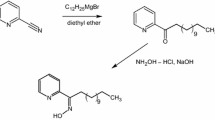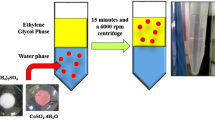Abstract
A microemulsion consisting of sodium laurate, n-pentanol, n-heptane and NaCl solution was investigated for Co(II) extraction. The dilution method and conductivity method were used for the determination of structural parameters of sodium laurate/pentan-1-ol/heptane/NaCl microemulsion system. Co(II) was found to be extracted into the microemulsion phase due to the compound formation of [CoCl]+[R11COO]−, which was confirmed by the continuous variation of R11COONa concentration. Moreover, the effects of cosurfactant, the contact time, the phase ratios, PH and the NaCl concentration in feed solutions on the cobalt extraction yield were investigated. Under the optimum conditions, the extraction percentage of Co(II) could reach 98.9%.









Similar content being viewed by others
References
Sivagami IN, Prasanna K, Santhoshkumar P, Jo YN, Seo GY, Lee CW (2017) Agar templated electrodeposition of binary zinc-cobalt alloy and formation of zinc-cobalt-carbon nanocomposite for application in secondary lithium batteries. J Alloy Compd 697:450–460. https://doi.org/10.1016/j.jallcom.2016.08.177
Ansari SM, Bhor RD, Pai KR, Sen D, Mazumder S, Ghosh K, Kolekar YD, Ramana CV (2017) Cobalt nanoparticles for biomedical applications: facile synthesis, physiochemical characterization, cytotoxicity behavior and biocompatibility. Appl Surf Sci 414:171–187. https://doi.org/10.1016/j.apsusc.2017.03.002
Zhang W, Du X, Tan Y, Hu J, Li Z, Tang B (2017) Amorphous cobalt boron alloy @ graphene oxide nanocomposites for pseudocapacitor applications. J Mater Sci Technol 33(5):438–443. https://doi.org/10.1016/j.jmst.2016.06.012
Wang Z-L, Yan J-M, Wang H-L, Jiang Q (2013) Self-protective cobalt nanocatalyst for long-time recycle application on hydrogen generation by its free metal-ion conversion. J Power Sources 243:431–435. https://doi.org/10.1016/j.jpowsour.2013.05.193
Hadi P, Barford J, McKay G (2013) Synergistic effect in the simultaneous removal of binary cobalt–nickel heavy metals from effluents by a novel e-waste-derived material. Chem Eng J 228:140–146. https://doi.org/10.1016/j.cej.2013.04.086
Wang Q, Qin W, Chai L, Li Q (2014) Understanding the formation of colloidal mercury in acidic wastewater with high concentration of chloride ions by electrocapillary curves. Environ Sci Pollut Res Int 21(5):3866–3872. https://doi.org/10.1007/s11356-013-2379-1
Repo E, Kurniawan TA, Warchol JK, Sillanpaa ME (2009) Removal of Co(II) and Ni(II) ions from contaminated water using silica gel functionalized with EDTA and/or DTPA as chelating agents. J Hazard Mater 171(1–3):1071–1080. https://doi.org/10.1016/j.jhazmat.2009.06.111
Kokkinos C, Economou A (2016) Microfabricated chip integrating a bismuth microelectrode array for the determination of trace cobalt(II) by adsorptive cathodic stripping voltammetry. Sens Actuators B Chem 229:362–369. https://doi.org/10.1016/j.snb.2016.01.148
Azimi A, Azari A, Rezakazemi M, Ansarpour M (2017) Removal of heavy metals from industrial wastewaters: a review. ChemBioEng Rev 4(1):37–59. https://doi.org/10.1002/cben.201600010
Tsakiridis PE, Agatzini SL (2004) Simultaneous solvent extraction of cobalt and nickel in the presence of manganese and magnesium from sulfate solutions by Cyanex 301. Hydrometallurgy 72(3–4):269–278. https://doi.org/10.1016/s0304-386x(03)00180-4
Hachemaoui A, Belhamel K (2017) Simultaneous extraction and separation of cobalt and nickel from chloride solution through emulsion liquid membrane using Cyanex 301 as extractant. Int J Miner Process 161:7–12. https://doi.org/10.1016/j.minpro.2017.02.002
Gupta B, Deep A, Singh V, Tandon SN (2003) Recovery of cobalt, nickel, and copper from sea nodules by their extraction with alkylphosphines. Hydrometallurgy 70(1–3):121–129. https://doi.org/10.1016/s0304-386x(03)00052-5
Mubarok MZ, Hanif LI (2016) Cobalt and nickel separation in nitric acid solution by solvent extraction using Cyanex 272 and Versatic 10. Proced Chem 19:743–750. https://doi.org/10.1016/j.proche.2016.03.079
Wieszczycka K, Krupa M, Wojciechowska A, Wojciechowska I, Olszanowski A (2016) Equilibrium studies of cobalt(II) extraction with 2-pyridineketoxime from mixed sulphate/chloride solution. J Radioanal Nucl Chem 307:1155–1164. https://doi.org/10.1007/s10967-015-4246-7
Zhu Z, Yoko P, Cheng CY (2017) Recovery of cobalt and manganese from nickel laterite leach solutions containing chloride by solvent extraction using Cyphos IL 101. Hydrometallurgy 169:213–218. https://doi.org/10.1016/j.hydromet.2017.02.002
Watarai H (1997) Microemulsions in separation sciences. J Chromatogr A 780(1–2):93–102
Dantas TNC, Neto AAD, Moura MCPA, Neto ELB, Forte KR, Leite RHL (2003) Heavy metals extraction by microemulsions. Water Res 37(11):2709–2717. https://doi.org/10.1016/s0043-1354(03)00072-1
Gao S, Shen X, Chen Q, Gao H (2012) Solvent extraction of thorium(IV) using W/O microemulsion. Sci China Chem 55(9):1712–1718. https://doi.org/10.1007/s11426-012-4686-7
Shan Z, Yang YZ, Tao Z, Jian H, Luo CH (2005) Uranium(VI) extraction by Winsor II microemulsion systems using trialkyl phosphine oxide. J Radioanal Nucl Chem 265(3):419–421
Xia C-B, Yang Y-Z, Xin X-M, Wang S-X (2007) Extraction of rare earth metal samarium by microemulsion. J Radioanal Nucl Chem 275(3):535–540. https://doi.org/10.1007/s10967-007-6960-2
Lou Z, Cui X, Zhang S, Feng X, Shan W, Xiong Y (2016) Extraction of Re(VII) from hydrochloric acid medium by N263/TBP/n-heptane/NaCl microemulsion. Hydrometallurgy 165:329–335. https://doi.org/10.1016/j.hydromet.2016.01.004
Lu W, Lu Y, Liu F, Shang K, Wang W, Yang Y (2011) Extraction of gold(III) from hydrochloric acid solutions by CTAB/n-heptane/iso-amyl alcohol/Na2SO3 microemulsion. J Hazard Mater 186(2–3):2166–2170. https://doi.org/10.1016/j.jhazmat.2010.12.059
Saidi M, Khalaf H (2004) Using microemulsion for recovery of uranium from phosphoric acid of Annaba (Algeria). Hydrometallurgy 74(1–2):85–91. https://doi.org/10.1016/j.hydromet.2004.01.002
Liu F, Yang Y, Lu Y (2010) Extraction of germanium by the AOT microemulsion with N235 system. Ind Eng Chem Res 49(20):10005–10008
Zheng Y, Fang L, Yan Y, Lin S, Liu Z, Yang Y (2016) Extraction of palladium (II) by a silicone ionic liquid-based microemulsion system from chloride medium. Sep Purif Technol 169:289–295. https://doi.org/10.1016/j.seppur.2016.06.022
Tong Y, Han L, Yang Y (2012) Microemulsion extraction of Gold(III) from hydrochloric acid medium using ionic liquid as surfactant and extractant. Ind Eng Chem Res 51(50):16438–16443. https://doi.org/10.1021/ie301644t
Zhu T, Yang YZ, Liu ZY, Xia CB (2006) Extraction of cobalt by CTMAB–pentanol–heptane–HCl Winsor II microemulsion systems. J Radioanal Nucl Chem 267(2):401–406
Bardhan S, Kundu K, Chakraborty G, Saha SK, Paul BK (2015) The Schulman method of cosurfactant titration of the oil/water interface (dilution method): a review on a well-known powerful technique in interfacial science for characterization of water-in-oil microemulsions. J Surfactants Deterg 18(4):547–567. https://doi.org/10.1007/s11743-015-1694-6
Chai J, Zhang H, Liu N, Liu N, Chai H, Liu Z (2014) Comparison between phase behavior of gemini imidazoliums and monomeric ionic liquid surfactants in W/O microemulsion systems. J Dispers Sci Technol 36(1):129–135. https://doi.org/10.1080/01932691.2014.890108
Bowcott JE, Schulman JH (2015) Emulsions control of droplet size and phase continuity in transparent oil-water dispersions stabilized with soap and alcohol. Zeitschrift für Elektrochemie, Berichte der Bunsengesellschaft für physikalische Chemie 59(4):283–290
Li X, He G, Zheng W, Xiao G (2010) Study on conductivity property and microstructure of TritonX-100/alkanol/n-heptane/water microemulsion. Colloids Surf A 360(1–3):150–158. https://doi.org/10.1016/j.colsurfa.2010.02.026
Gao Y, Zhang J, Xu H, Zhao X, Zheng L, Li X, Yu L (2006) Structural studies of 1-butyl-3-methylimidazolium tetrafluoroborate/TX-100/p-xylene ionic liquid microemulsions. ChemPhysChem 7(7):1554–1561. https://doi.org/10.1002/cphc.200600120
Lagourette B, Peyrelasse J, Boned C, Clausse M (1979) Percolative conduction in microemulsion type systems. Nature 281:60–63
Laguës M (1979) Electrical conductivity of microemulsions: a case of stirred percolation. J de Phys Lett 40(14):331–333. https://doi.org/10.1051/jphyslet:019790040014033100
Klossek ML, Touraud D, Kunz W (2013) Highly and fully water dilutable sustainable microemulsions with dibasic esters as oil phase. ACS Sustain Chem Eng 1(6):603–610. https://doi.org/10.1021/sc300132x
Fang J, Venable RL (1987) Conductivity study of the microemulsion system sodium dodecyl sulfate-hexylamine-heptane-water. J Colloid Interface Sci 116(1):269–277
Liu J, Zhang X, Zhang H (2014) Water/AOT/IPM/alcohol reverse microemulsions: influence of salts and nonionic surfactants on structure and percolation behavior. J Chem Thermodyn 72:1–8. https://doi.org/10.1016/j.jct.2013.12.026
Murashova NM, Levchishin SY, Yurtov EV (2014) Effect of Bis-(2-ethylhexyl)phosphoric acid on sodium Bis-(2-ethylhexyl)phosphate microemulsion for selective extraction of non-ferrous metals. J Surfactants Deterg 17(6):1249–1258. https://doi.org/10.1007/s11743-014-1598-x
Wang W, Yang YZ, Zhao H, Guo QW, Lu WJ, Lu YM (2012) Extraction of europium by sodium oleate/pentanol/heptane/NaCl microemulsion system. J Radioanal Nucl Chem 292(3):1093–1098
Wang S, Zheng Y, Zhang H, Yan Y, Xin X, Yang Y (2016) Ionic-liquid-type imidazolium gemini surfactant based water-in-oil microemulsion for extraction of gold from hydrochloric acid medium. Ind Eng Chem Res 55(10):2790–2797. https://doi.org/10.1021/acs.iecr.5b04115
Lou Z, Guo C, Feng X, Zhang S, Xing Z, Shan W, Xiong Y (2015) Selective extraction and separation of Re(VII) from Mo(VI) by TritonX-100/N235/iso-amyl alcohol/n-heptane/NaCl microemulsion system. Hydrometallurgy 157:199–206. https://doi.org/10.1016/j.hydromet.2015.08.017
ZhengHong LUO, XiaoLi ZHAN, PengYong YU (2004) Effect of addition of cosurfactant on the phase behaviour of oil-in-water aminosilicone oil microemulsion. Chin Chem Lett 15(9):1101–1104
Acknowledgements
We acknowledge the support by National Key Basic Research Program of China (2014CB748500) and National Natural Science Foundation of China (51578239, 51322805).
Author information
Authors and Affiliations
Corresponding author
Rights and permissions
About this article
Cite this article
Jie, F., Bai, Z. & Yang, X. Study on extraction of cobalt(II) by sodium laurate/pentan-1-ol/heptane/NaCl microemulsion system. J Radioanal Nucl Chem 315, 581–593 (2018). https://doi.org/10.1007/s10967-017-5685-0
Received:
Published:
Issue Date:
DOI: https://doi.org/10.1007/s10967-017-5685-0




